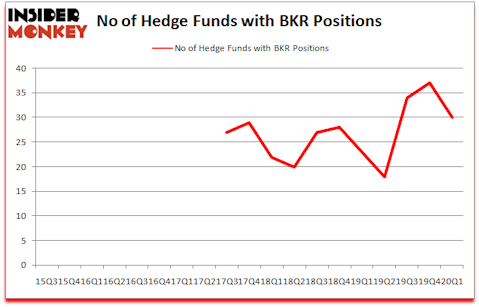We know that hedge funds generate strong, risk-adjusted returns over the long run, which is why imitating the picks that they are collectively bullish on can be a profitable strategy for retail investors. With billions of dollars in assets, professional investors have to conduct complex analyses, spend many resources and use tools that are not always available for the general crowd. This doesn’t mean that they don’t have occasional colossal losses; they do. However, it is still a good idea to keep an eye on hedge fund activity. With this in mind, let’s examine the smart money sentiment towards Baker Hughes Company (NYSE:BKR) and determine whether hedge funds skillfully traded this stock.
Baker Hughes Company (NYSE:BKR) was in 30 hedge funds’ portfolios at the end of March. BKR has experienced a decrease in activity from the world’s largest hedge funds of late. There were 37 hedge funds in our database with BKR holdings at the end of the previous quarter. Our calculations also showed that BKR isn’t among the 30 most popular stocks among hedge funds (click for Q1 rankings and see the video for a quick look at the top 5 stocks).
Video: Watch our video about the top 5 most popular hedge fund stocks.
Hedge funds’ reputation as shrewd investors has been tarnished in the last decade as their hedged returns couldn’t keep up with the unhedged returns of the market indices. Our research was able to identify in advance a select group of hedge fund holdings that outperformed the S&P 500 ETFs by more than 58 percentage points since March 2017 (see the details here). We were also able to identify in advance a select group of hedge fund holdings that’ll significantly underperform the market. We have been tracking and sharing the list of these stocks since February 2017 and they lost 36% through May 18th. That’s why we believe hedge fund sentiment is an extremely useful indicator that investors should pay attention to.
At Insider Monkey we scour multiple sources to uncover the next great investment idea. We read hedge fund investor letters and listen to stock pitches at hedge fund conferences. Hedge fund sentiment towards Tesla reached its all time high at the end of 2019 and Tesla shares more than tripled this year. We are trying to identify other EV revolution winners, so we are checking out this tiny lithium stock. With all of this in mind let’s take a look at the key hedge fund action regarding Baker Hughes Company (NYSE:BKR).
What have hedge funds been doing with Baker Hughes Company (NYSE:BKR)?
At Q1’s end, a total of 30 of the hedge funds tracked by Insider Monkey were long this stock, a change of -19% from one quarter earlier. The graph below displays the number of hedge funds with bullish position in BKR over the last 18 quarters. So, let’s examine which hedge funds were among the top holders of the stock and which hedge funds were making big moves.
When looking at the institutional investors followed by Insider Monkey, Richard S. Pzena’s Pzena Investment Management has the biggest position in Baker Hughes Company (NYSE:BKR), worth close to $155.6 million, amounting to 1.2% of its total 13F portfolio. On Pzena Investment Management’s heels is Citadel Investment Group, managed by Ken Griffin, which holds a $17.2 million position; less than 0.1%% of its 13F portfolio is allocated to the company. Some other professional money managers that are bullish comprise D. E. Shaw’s D E Shaw, John Overdeck and David Siegel’s Two Sigma Advisors and Steve Cohen’s Point72 Asset Management. In terms of the portfolio weights assigned to each position AltraVue Capital allocated the biggest weight to Baker Hughes Company (NYSE:BKR), around 3.14% of its 13F portfolio. Deep Basin Capital is also relatively very bullish on the stock, earmarking 2.36 percent of its 13F equity portfolio to BKR.
Since Baker Hughes Company (NYSE:BKR) has faced bearish sentiment from the aggregate hedge fund industry, it’s safe to say that there were a few hedge funds who sold off their full holdings last quarter. It’s worth mentioning that Dmitry Balyasny’s Balyasny Asset Management said goodbye to the biggest investment of all the hedgies followed by Insider Monkey, totaling close to $26.9 million in stock. Brandon Haley’s fund, Holocene Advisors, also dropped its stock, about $11.5 million worth. These bearish behaviors are interesting, as aggregate hedge fund interest dropped by 7 funds last quarter.
Let’s now take a look at hedge fund activity in other stocks similar to Baker Hughes Company (NYSE:BKR). These stocks are UDR, Inc. (NYSE:UDR), SK Telecom Co., Ltd. (NYSE:SKM), Quest Diagnostics Incorporated (NYSE:DGX), and Datadog, Inc. (NASDAQ:DDOG). This group of stocks’ market valuations resemble BKR’s market valuation.
| Ticker | No of HFs with positions | Total Value of HF Positions (x1000) | Change in HF Position |
|---|---|---|---|
| UDR | 19 | 249574 | -2 |
| SKM | 5 | 117014 | -1 |
| DGX | 38 | 383257 | 7 |
| DDOG | 44 | 860690 | 12 |
| Average | 26.5 | 402634 | 4 |
View table here if you experience formatting issues.
As you can see these stocks had an average of 26.5 hedge funds with bullish positions and the average amount invested in these stocks was $403 million. That figure was $281 million in BKR’s case. Datadog, Inc. (NASDAQ:DDOG) is the most popular stock in this table. On the other hand SK Telecom Co., Ltd. (NYSE:SKM) is the least popular one with only 5 bullish hedge fund positions. Baker Hughes Company (NYSE:BKR) is not the most popular stock in this group but hedge fund interest is still above average. Our calculations showed that top 10 most popular stocks among hedge funds returned 41.4% in 2019 and outperformed the S&P 500 ETF (SPY) by 10.1 percentage points. These stocks gained 12.3% in 2020 through June 30th but still beat the market by 15.5 percentage points. Hedge funds were also right about betting on BKR as the stock returned 48.3% in Q2 and outperformed the market. Hedge funds were rewarded for their relative bullishness.
Follow Baker Hughes Co (NYSE:BKR)
Follow Baker Hughes Co (NYSE:BKR)
Disclosure: None. This article was originally published at Insider Monkey.


